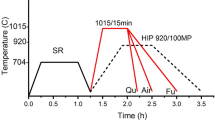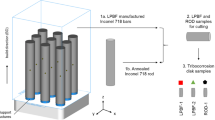Abstract
The influence of the amount of retained austenite on short fatigue crack growth and wear resistance in carburized SAE 8620 steel was studied in this article. Different amounts of retained austenite in the microstructure of the carburized case were obtained through different heat treatment routes applied after the carburizing process. The wear tests were carried out using pin on disk equipment. After every 200 turns the weight loss was registered. Four point bend fatigue tests were carried out at room temperature, using three different levels of stress and R=0.1. Crack length versus number of cycles and crack growth rate versus mean crack length curves were analyzed. In both tests the results showed that the test pieces with higher levels of retained austenite in the carburized case exhibited longer fatigue life and better wear resistance.
Similar content being viewed by others
References
G. Krauss, Microstructure, Residual Stress, and Fatigue of Carburized Steels, Proceedings: Quenching, and Carburizing (Melbourne), The Institute of Materials, 1991, p 205–225
J.V. Faria, Silva, 1993, Master Report—Escola Politécnica, Universidade de São Paulo, Brazil
G. Krauss, Microstructure and Performance of Carburized Steel. Part III: Austenite and Fatigue, Adv. Mater. Process., Vol 148 (No. 3), 1995, p 42EE-42II
M.A. Zaccone, J.B. Kelley, and G. Krauss, Fatigue and Strain Hardening of High Carbon Martensite-Austenite Composite Microstructures, Proceedings Heat Treatment ’87, The Institute of Metals, 1987, p 93–101
Z.Z. Hu, M.L. Ma, and J.H. Liu, J. Fatigue, Vol 19 (No. 8/9), 1997, p 641–646
J.S. Boabaid, “The Effect of Manufacturing Variables on Short Fatigue Crack Growth in Waspaloy at 19 °C,” Second Progress Report, University of Sheffield, Sheffield, 1993
E.R. De Los Rios, A. Walley, M.T. Milan, and G. Hammersley, Fatigue Crack Initiation and Propagation on Shot Peened Surfaces in A316 Stainless Steel, Int. J. Fatigue, Vol 17 (No. 7), 1995, p 493–499
R.S. Hyde, G. Krauss, and D.K. Matlock, Phosphorus and Carbon Segregation: Effects on Fatigue and Fracture of Gas Carburized Modified 4320 Steel, Metal. Mater. Trans. A, Vol 25 (No. 6), 1994, p 1229–1240
Z. Mei and J.W. Morris, Influence of Deformation-Induced Martensite on Fatigue Crack-Propagation in 304 Type Steels, Metal. Trans. A, Vol 21 (No. 12), 1980, p 3137–3152
M.A. Panhans and R.A. Fournelle, High Cycle Fatigue Resistance of AISI E9310 Carburized Steel with Two Different Levels of Surface Retained Austenite and Surface Residual Stress, J. Heat Treat., Vol 2 (No. 1), 1981, p 54–61
C. Gu, B. Lou, X. Jing, and F. Shen, Mechanical Properties of Carburized Cr-Ni-Mo Steels with Added Case Nitrogen, J. Heat Treat., Vol 7 (No. 2), 1989, p 87–94
B. Lou, X. Jing, C. Gu, F. Shen, and L. He, Fatigue Crack Growth and Closure Behaviors in Carburized and Hardened Case, Proceedings Fatigue ’90 (Honolulu), Birmingham, Materials and Component Engineering Publications, 1990, p 1161–1166
Author information
Authors and Affiliations
Rights and permissions
About this article
Cite this article
da Silva, V.F., Canale, L.F., Spinelli, D. et al. Influence of retained austenite on short fatigue crack growth and wear resistance of case carburized steel. J. of Materi Eng and Perform 8, 543–548 (1999). https://doi.org/10.1007/s11665-999-0007-5
Received:
Revised:
Issue Date:
DOI: https://doi.org/10.1007/s11665-999-0007-5




